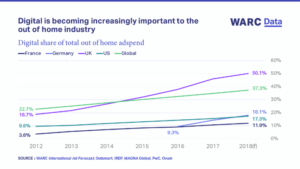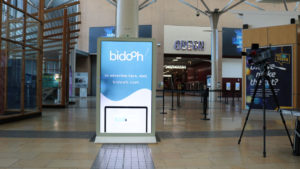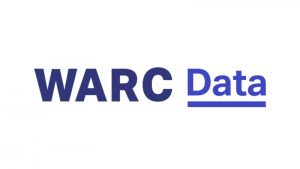 Spend on digital out of home advertising (DOOH) — i.e. video content and/or digital signs located in high traffic public locations such as high streets, airports, bus shelters, subways and malls — is expected to grow 10.1% each year between 2018 and 2021, accounting for the entirety of growth in the out of home (OOH) market as spend on traditional sites begins to decline from next year.
Spend on digital out of home advertising (DOOH) — i.e. video content and/or digital signs located in high traffic public locations such as high streets, airports, bus shelters, subways and malls — is expected to grow 10.1% each year between 2018 and 2021, accounting for the entirety of growth in the out of home (OOH) market as spend on traditional sites begins to decline from next year.
Digital’s share of total global OOH adspend is expected to rise to 37.3% — or $14.6bn — this year, up from 34.8% in 2017, 32.4% in 2016 and 22.7% in 2012. The rapid growth of DOOH is driven in part by the higher cost-per-thousand (CPM) the format commands, but also the rising penetration of digital panels and the opportunity to combine data-driven targeting with powerful, dynamic creative.
DOOH’s share is rising at a time when providers are accelerating site investment
 Major providers are accelerating investment in digital sites, and this will further fuel growth over the coming years. JCDecaux is building on its existing base of 59,744 digital screens worldwide with the ongoing digitalisation of street furniture in New York, Chicago and London. Clear Channel added 450 new digital screens last year, taking its global total to 14,510, while Lamar intends to add 300 screens in 2019, adding to its existing base of 2,800.
Major providers are accelerating investment in digital sites, and this will further fuel growth over the coming years. JCDecaux is building on its existing base of 59,744 digital screens worldwide with the ongoing digitalisation of street furniture in New York, Chicago and London. Clear Channel added 450 new digital screens last year, taking its global total to 14,510, while Lamar intends to add 300 screens in 2019, adding to its existing base of 2,800.
In terms of markets, adspend figures from the latest AA/WARC Expenditure Report show half of UK’s OOH ad investment is expected to be spent on digital sites this year, equating to £593m ($770m). MAGNA forecast spend in the US to reach $1.2bn, up from $582m in 2012. The Direct Place-based Advertising Association (DPAA) believes $100m of this will be traded programmatically, up from $65m in 2017.
In Germany, where Google is exploring DOOH opportunities, spend is expected to reach $285m — 18% of the OOH market and more than double the amount invested two years ago; and in France, the share is forecast to be 11.9% ($183m) this year.
DOOH can deliver powerful creative in high-traffic locations
 Data from the Outdoor Advertising Association of America (OAAA) show that digital billboards now account for 21% of all billboards in the country, and research by Nielsen show that approximately 60% of US consumers see a digital billboard each month and 37% see one each week.
Data from the Outdoor Advertising Association of America (OAAA) show that digital billboards now account for 21% of all billboards in the country, and research by Nielsen show that approximately 60% of US consumers see a digital billboard each month and 37% see one each week.
In the UK, DOOH plays a core role in the daily commute, generating £152m in adspend for Transport for London. The power of the medium is such that Global, UK’s largest commercial radio group, recently moved into the DOOH sector by acquiring Exterion, Primesight and Outdoor Plus, gaining 30% in market share.
A strength of DOOH is the delivery of dynamic creative, using real-time and predictive triggers to ensure the most relevant ad is surfaced to the right people, in the right place, at the right time. The rise of digital screens, particularly on the high street, gives advertisers more choice in where and when their ad is placed, while the creative itself — especially if video — can be powerful.
OOH drives online activation, demonstrating a synergy with consumers’ mobile habits
 Search is a key benefactor when included in the mix with OOH — mobile click through rates (CTRs) increase by up to 15% when supported by OOH. Data show 46% of US consumers used a search engine as a result of seeing an OOH ad, while 38% went on to use Facebook.
Search is a key benefactor when included in the mix with OOH — mobile click through rates (CTRs) increase by up to 15% when supported by OOH. Data show 46% of US consumers used a search engine as a result of seeing an OOH ad, while 38% went on to use Facebook.
The outdoor ad revolution is not, however, problem-free. The collection of mobile phone data, for both targeting and measurement, raises privacy concerns. This is cited as a particular issue by almost one in three mobile marketers. And criticisms of the online-ad business for being opaque, and occasionally fraudulent, may also be directed at the OOH business as it becomes bigger and more complex.
While DOOH provides the opportunity of improved targeting through facial recognition, consumers are yet to be sold on the idea. A full 65.2% of those surveyed by WARC and Toluna were not happy for facial recognition to be used for personalised marketing messages.
 James McDonald, Data Editor, WARC, concludes: “The combined power of digital out of home and mobile location data can be used to add greater targeting capabilities to a broadcast medium, serving programmatically-traded creative by the hour to the right people, in the right place, at the right time. This is an enticing prospect for advertisers looking to leverage digital’s strengths without the risk of ad blocking, fraud, and risk to brand safety.”
James McDonald, Data Editor, WARC, concludes: “The combined power of digital out of home and mobile location data can be used to add greater targeting capabilities to a broadcast medium, serving programmatically-traded creative by the hour to the right people, in the right place, at the right time. This is an enticing prospect for advertisers looking to leverage digital’s strengths without the risk of ad blocking, fraud, and risk to brand safety.”
Global media analysis: A round-up of DOOH
- 10.1% compound annual growth rate for DOOH to 2021
- 15% increase in mobile click through rates when used with OOH
- 21% billboards in America which are now digital
- 37% Americans who see a digital billboard at least once a week
- 50.1% DOOH’s share of UK OOH adspend this year
- 66.9% consumers who are unaware that facial recognition technology can be used to measure mood
- Amazon Prime Day more valuable than Black Friday/Cyber Monday
- Global programmatic market to reach $75bn this year
- Brand knowledge and cost efficiencies are main in-house agency benefits
- Evaluating digital spend has become more difficult in the UK

You must be logged in to post a comment Login